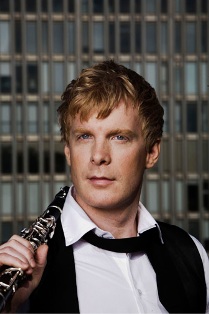
Fröst, “Amériques” Propel CSO Show

Martin Fröst
|
Edgar Varèse’s “Amériques” shook the timbers of Music Hall Friday night, but it was a clarinetist from Sweden who stole the show.
Making his debut with the Cincinnati Symphony Orchestra led by music director Paavo Järvi was Martin Fröst, charisma and all. Fröst, whose threads announced him – he was dressed in black jacket and trousers piped in white – put showmanship into his performance of the Clarinet Concerto by Aaron Copland. (And well he might, since the concerto was choreographed by Jerome Robbins for the New York City Ballet and Benny Goodman himself performed it onstage.)
Needless to say, that is not all that went into Fröst’s performance. He demonstrated, even as he swayed right and left and literally danced to the music, that he can do anything on the clarinet. And it was not all sparks and high voltage stuff – he thrust his clarinet high and played to the gallery for that – but he exhibited a flexible tone and super-sensitive musicality. The first movement, “Slowly and expressively,” was just that, languorous, lovely and couched in an incredibly silken tone against gentle harp accents.
The cadenza, which he introduced almost stealthily, was thrilling in its virtuosity and no challenge seemed beyond his reach. The jazz inflections of the second movement, “Rather Fast,” which sounded as if it would break into “Appalachian Spring” at any moment, built to a breathtaking pace and a surprise ending that evoked bravos from the happy crowd. Fröst accommodated them with an even more highly charged encore, “Klezmer Dances,” arranged by Goran Fröst (his younger brother). It was both expressive and impressive, filled with ornamentation and almost spoken inflection. Fröst, 40, who is well known in Europe, is making the rounds of U.S. orchestras and chances are, he will soon become as popular on this side of the Atlantic, too.
The all-American program -- if you count Franco-American Edgar Varèse, who made the U.S. his home from 1915 onwards -- was one of the freshest and most delightful in recent memory by the CSO. There were the Three Dance Episodes from “On the Town” by Leonard Bernstein and the Fugue, ”from Greenland’s Icy Mountains,” from Charles Ives’ Symphony No. 4, both in their CSO subscription premieres.
Best of all, it opened with a world premiere, “P.J. Fanfare” by New Yorker Charles Coleman. Composed in honor of Järvi’s 10th and final season as CSO music director, it spoke joyfully and eloquently, recalling Coleman’s “Streetscape,” performed on Järvi’s inaugural concert in September, 2001.
Set for full orchestra, it opened with fanfare-like brass against steady rhythms by percussion (cymbal, cow bell). The full orchestra took over for a three-minute celebration with catchy syncopation and horns bubbling up through the texture. A momentary flute-piccolo episode diverted attention from the sudden, jumping-with-joy conclusion. Coleman was there to take the applause and salute Järvi and the CSO.
Ives’ Fugue, set for strings, single winds and organ and based on the hymn by Lowell Mason, is a somewhat ambiguous evocation of the spiritual foundations of American life. Serious, studied and sonorous, it is fraught with both questioning and conviction, and Järvi and the CSO read it with insight.
Bernstein’s great Broadway legacy was toasted handsomely with the Three Dance Episodes from “On the Town,” his 1944 musical about three sailors on shore leave in the Big Apple. Järvi, who studied with Bernstein after emigrating from Estonia in 1980, filled it with color and gesture. Principal trombonist Cristian Ganicenco announced the theme of “The Great Lover” (first episode). The clarinet choir set the mournful tone for “Lonely Town,” which was capped by trumpeter Doug Lindsay's touching, muted solo. However, nothing quite equaled Jonathan Gunn’s sassy, blatant E-flat clarinet in “Times Square 1944,” where the composer demonstrated how many ways he could flavor “New York, New York” with jazz.
“Amériques” is America’s “Rite of Spring” (Stravinsky) and it is amazing how often elements of Stravinsky’s masterpiece (themes, harmonies, rhythms) get sampled in it. Instead of a pagan ritual, it is a testament to the industrial age – and the great unknown that lay beyond at the time of its writing (1918-21). Järvi showed himself a master in burnishing its colors, from soft and vaguely impressionistic to explosive and cataclysmic. Flutist Jasmine Choi’s opening alto flute solo recalled not only Debussy’s “Prelude to the Afternoon of a Faun” but the eerie bassoon solo that opens Stravinsky’s “Rite.” It is a recurring theme, angled between expositions of orchestral might, laced with slashing brass dissonances and a recurring siren for a mid-town effect (an actual fire truck siren, ably calibrated from a soft alarm to a piercing scream by percussionist Mark Wolfley).
High winds lent an exotic Old World impression at one point, but always there was that siren to anchor one in the New World. As it drew to an end, one felt as if the universe were laboring to bring forth a monster, and in fact, Järvi ratcheted up the orchestra to the kind of ear-splitting decibel level that only Music Hall can absorb with ample justice.
The audience responded with enthusiasm (as, in fact, they did when former music director Michael Gielen led the last performance of “Amériques” at Music Hall in 1984, according to violist Paul Frankenfeld who was there).
Overheard on the way out of the hall: “I normally don’t like those atonal pieces, but . . .” The music – the sheer power of it – spoke volumes.
The concert repeats at 8 p.m. tonight in Music Hall. Tickets begin at $10, available at www.cincinnatisymphony.org or by calling (513) 381-3300.